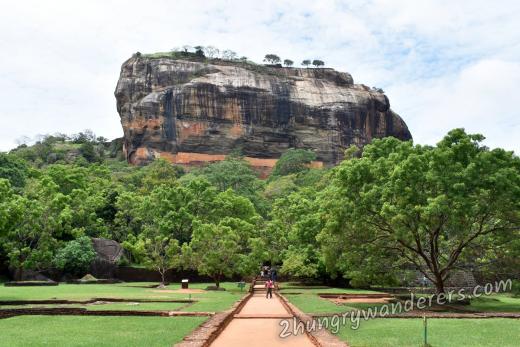
Also called the Lion's Rock, The Eight Wonder of the world and included nearly in every "Top X places to visit in Sri Lanka" list, Sigiriya Rock Fortress is undoubtedly one of the country's most famous attractions. This UNESCO world heritage site has a lot to offer and here I will walk you up and down the rock and will show you all of the popular and some of the less known sights.
Lion's Rock Fortress is the main attraction in the small town of Sigiriya, for more things you can do there check our article
Many mysteries surround the history of the famous area. There is evidence that people have lived there since prehistoric times, but many theories exist about the remains of the buildings we see today. The most popular and established theory is that Kasyapa was not the rightful heir, but he took over the throne from his father King Dhatusena by force in 477 AD. As the supporters of the rightful king expected strong support from India, King Kasyapa (477 - 495 AD) moved the capital from Anuradhapura to Sigiriya, a place he turned into an impenetrable fortress-palace and a prosperous city developed around it. The majority of buildings that are visible today have been built during this period.
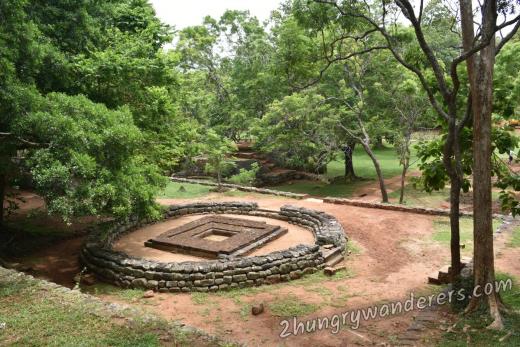
People rarely talk about Sigiriya without mentioning the high price of the attraction, I have left this discussion as the last point in my article, wanted to focus on the positives first.
An early start is a good idea because the top of the rock has almost no shade at all. I have arranged the points of interest in the same order as one would reach them by going up the main path, but in fact, we rushed to the top first and I recommend you do the same if you prefer to spend less time climbing in the midday heat. After this, the lower levels and gardens offer some shade and exploring them is a pleasure.
Water gardens
Walking from the main entrance of the complex towards the rock the first area visitors enter is the water gardens. The main path is also an axis of symmetry for the pools, just the ones on the right side are restored, but most of the left side is untouched in recent centuries. These gardens are a true technological achievement of the ancient people as the fountains and lakes are fed and drained by a complex system of canals, dams and pumps, both underground and on the surface. Now, as many centuries ago, they are a wonderful opportunity for a relaxing walk.
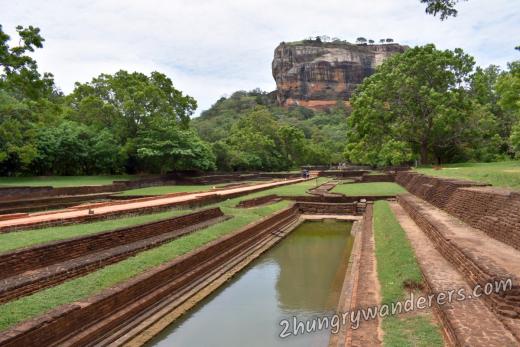
There are some man-made islands in the gardens, where a secondary palace has been built. The palace is still awaiting to be fully excavated and currently, the islands are off-limits for tourists. We joked that maybe the king didn't like going up and down to the main palace, so he built the "summer" palace to avoid the long climb.
Boulder gardens
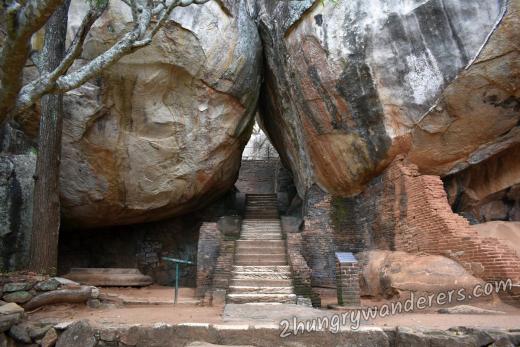
One of the most mysterious areas in Sigiriya, the huge boulders here form many passages and caves that have been used for millennia. To what degree their current position can be attributed to the people who build the palace is unknown. Many of the boulders have holes and flat surfaces that were probably used to support the foundations of buildings. Some of the caves hold interesting remainders of the past - altars or stone beds, brick walls and traces of colourful paintings. At least an hour can be spent just exploring this area and wondering what it actually looked like when it was inhabited by the royal court, or later - by monks.
Terraced gardens
The lower section of the hill between the boulders and the Lion's paws has been transformed into flat gardens using brick walls, similar to rice terraces. This gardens must have had a more functional role as they lack the beauty and sophistication of the water gardens and the history of the boulders.
While walking along the main path you will encounter an important intersection, unfortunately without any indication where each direction leads. Straight is the path towards the top of the hill, our advice is to do this first. If you choose the right path, it will take you to the mirror wall and frescoes gallery. There the path is narrow and marked as one-way, which was not enforced when we visited, but maybe during busier times, people will not be allowed to go back. This will mean a very long detour, if you go to the frescoes first and want to climb the rock afterwards.
Lion's paws and staircase
On the highest terrace is the monument most often used to represent Sigiriya - two paws of an enormous lion framing the foot of the staircase leading to the rock summit. Sadly, just the front paws remain of what must have been an amazing statue with the staircase going right into the lion's mouth.
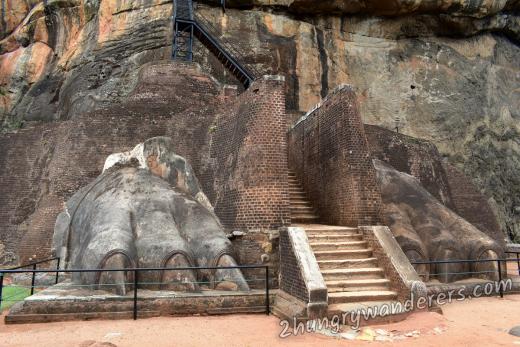
What follows is the main climb, so the lion's paws are not just a photo opportunity you should not miss, but a chance to catch your breath before going up the numerous steps. Older reports mention a dangerous and difficult climb over the original steps carved in the rock, but now there is a metal staircase with rails on each side that feels safe and solid.
The summit
Reaching the highest point was a tiny bit of a letdown. The views are awesome in every direction, closest and easiest to spot of the nearby landmarks is the Pidurangala rock.
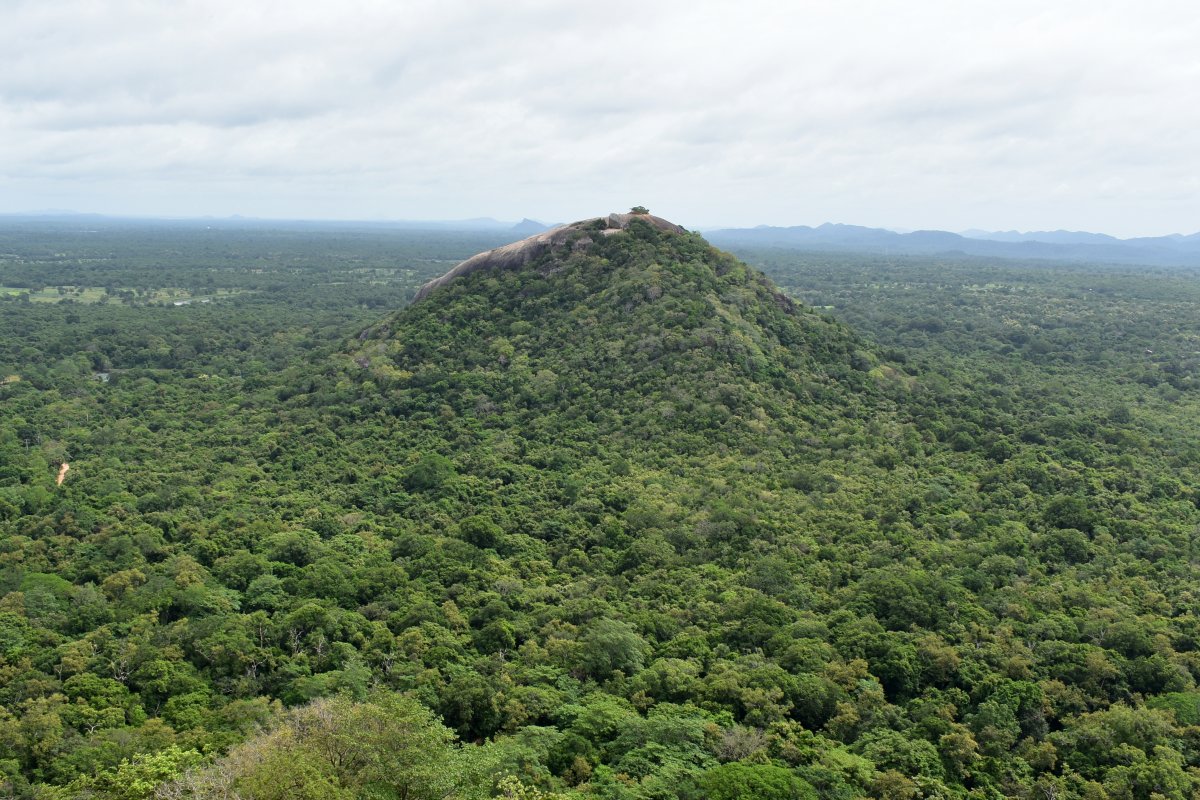
What is left from the buildings on top is just restored foundations, which fail to impress, with just a couple of exceptions. A large bathing pool is the centre of attention, looks like nobody leaves without taking some selfies with it. I got the impression, that locals consider it the only note-worthy place at the summit. The central pond is surrounded by brick staircases which indicate the scale of the buildings that once covered the tall rock.
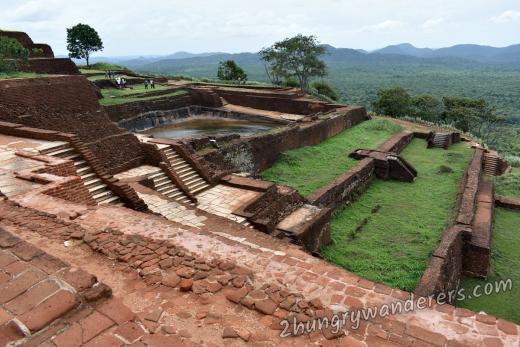
A perfectly smooth throne is carved out of the rock remains in situ, a large rectangular surface with in-built back support which may even be called a "cushion". Strangely, it is not in a central position, but currently sits in what looks like to have been a hallway.
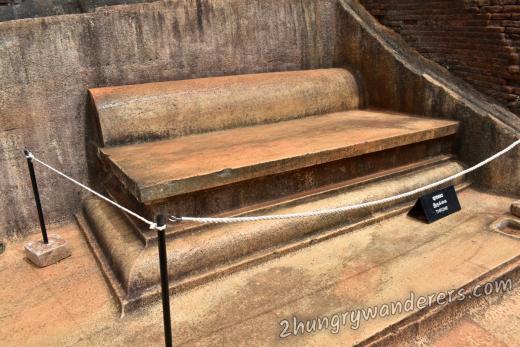
Apart from those, the top doesn't offer much more to see, so the best approach is to head for the higher vantage points and feel free to skip walking around the whole place.
Going down the steps is much easier and soon you will find yourself at the intersection we mentioned earlier in the terraced gardens. Head left and soon you will reach the Mirror Wall, walking past it will take you to a spiral staircase leading to a unique art gallery.
Mirror wall - Sigiriya Graffiti
A long time ago the tall brick wall was covered in white plaster and polished so perfectly that the king could see his reflection when walking past it, hence the name - Mirror Wall. It is still super smooth in some spots, but the no longer reflective surface is even more interesting now. A visitors book of sorts, the wall contains over 1800 writings from ancient tourists scribbled over a period of 800 years and the oldest have been dated as far back as the 8th century.
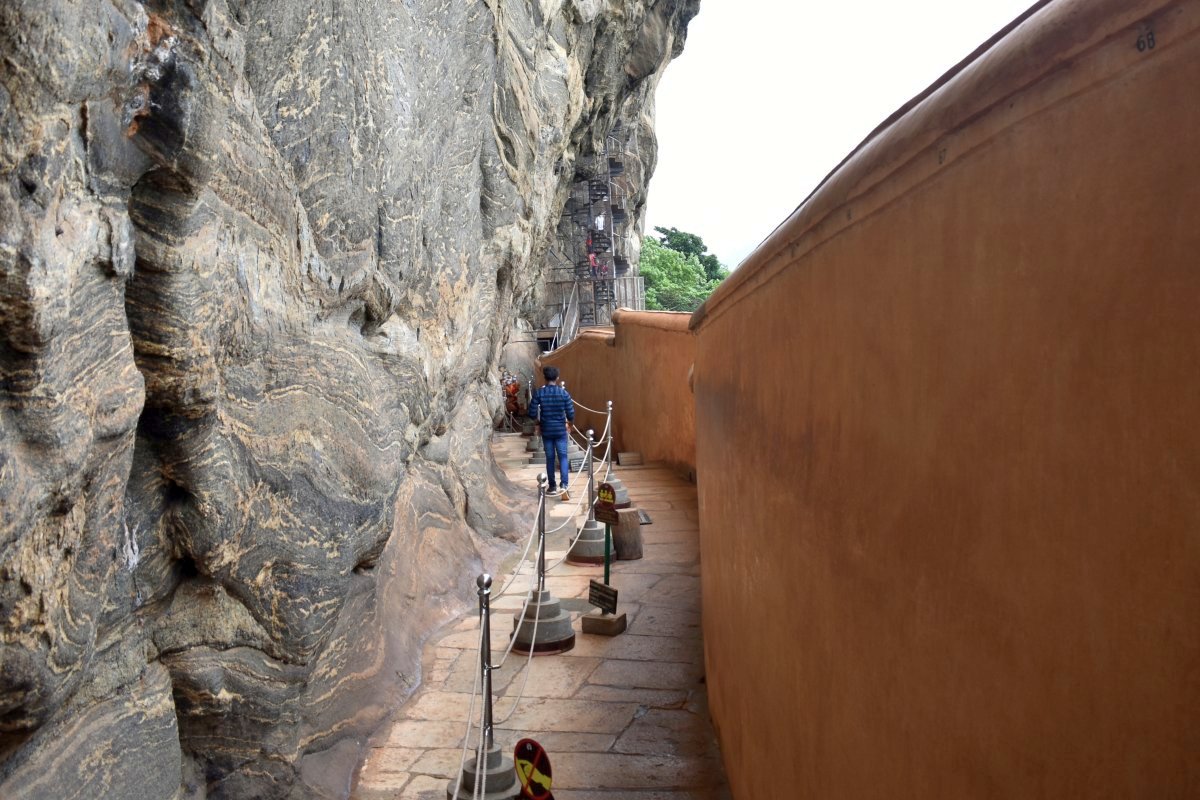
The texts give a unique insight into the history of Sri Lanka as many people included their names, professions and home towns. Hundreds of different authors have been identified so far, most of which had higher social position - government officials, teachers, priests, high ranking soldiers. It is not clear if travelling used to be a privilege for the rich or simply the lower classes visited the place as well, but did not "sign the guest book" due to being illiterate.
The contents of the writings cover a wide range of emotions from simple "I was here" through expressions of astonishment from the site to truly inspired poetry. The wall holds many poems praising the beauty of the semi-naked ladies from the paintings. A great example of art inspiring art, between the scribbles, there are numerous verses proclaiming love, adoration and worship of the heavenly women.
Frescoes - the Sigiriya Ladies
Ancient texts mention vast areas of the rock covered in paintings depicting over 500 women, which surely has been one of the largest works of art on the island. Today only eighteen of the beautiful damsels remain in a small niche on the western side of the rock, most likely protected from the elements by their location.
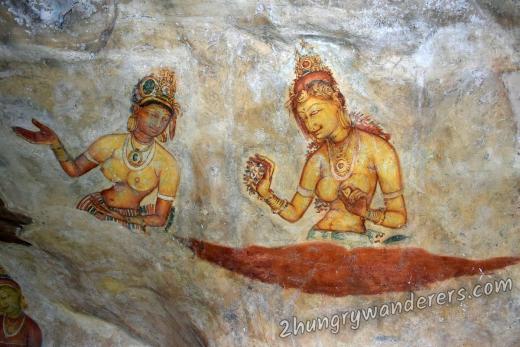
The Sigiriya Ladies are a true masterpiece, a celebration of female beauty, there are intricate details in their jewellery and faces. Many carry flowers as part of a religious ritual, most are smiling. The artist put a really strong emphasis on their femininity by portraying them topless and with cup sizes guaranteed to attract attention.
Many questions about those paintings remain unsolved - for example, they are dated back to the Anuradhapura period, but the style of applying paint is different from the rest of the artwork from that age.
The biggest mystery is the identity of the ladies. Some believe they are portraits of King Kasyapa’s wives and concubines, this theory is supported by the fact that every woman has distinct facial features. Others are convinced that the beautiful ladies are in fact priestesses or goddesses because they are represented sitting on clouds, a common attribute of divine creatures.

During the excavation of the historic site, archeologists have found clay figurines very closely resembling the painted ladies. Considering their mass production, it is assumed they were sold as souvenirs to the visitors in ancient times.
Is Sigiriya Rock Fortress worth its high price?
The entrance ticket for foreigners is $30. It is the most expensive tourist attraction in the country and many people do not think this price is appropriate. It is even higher than the 5-day pass for Bagan in Myanmar, which is $25 and exploring a whole valley with thousands of temples over five days gives you incomparably more in every aspect than climbing the fortress.
After visiting Sigiriya I agree, it is a nice place and worth visiting, but the price is way too high. I think for that price tourists deserve at least some signs pointing to the different spots and information boards that are not faded and almost impossible to read. Accepting credit cards would be nice too, but I guess the owners of the high-fee ATM on site are quite happy with the "cash only" policy.
Also, it might be just me but they could've used some of our money to do something about the huge wasp hives instead of just putting up warning signs.
To make things even worse think about the difference in the ticket cost depending on your nationality. For foreigners, the $30 are converted to rupees based on the daily rate, on our visit we had to pay 5640 LKR per person. Locals pay 50 rupees. Yes, we pay 113 times the local fee. I generally understand and approve double pricing, foreigners being charged two, three, five times more is something I never complain about, but more than a hundred times is just insulting.
The decision is yours - if you are on a tight budget, just skip the famous rock, but if you are set on visiting the top attractions get your wallet ready.
Gallery
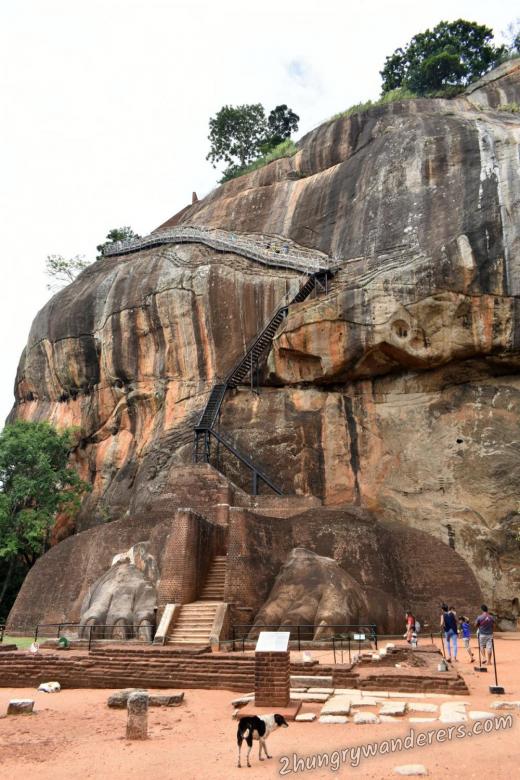
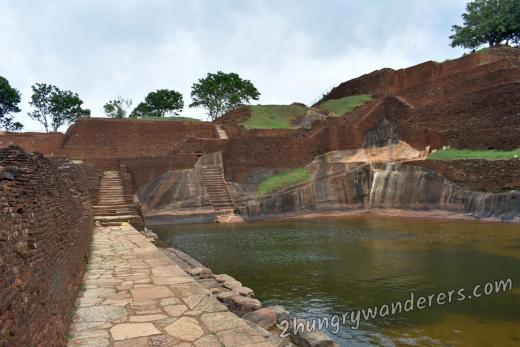
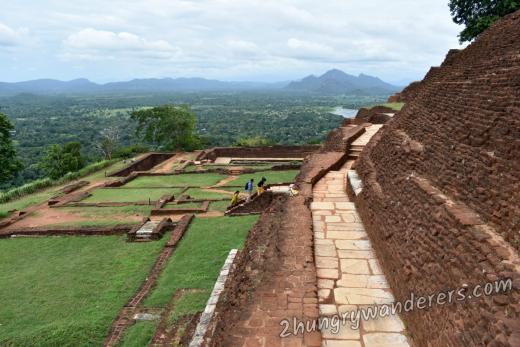
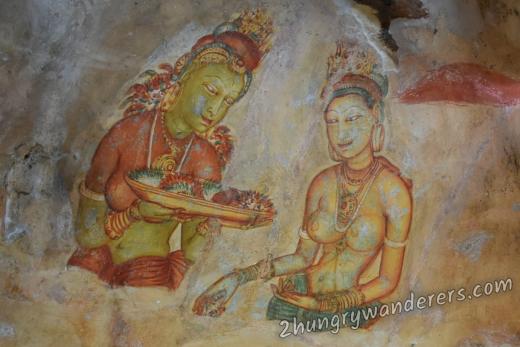
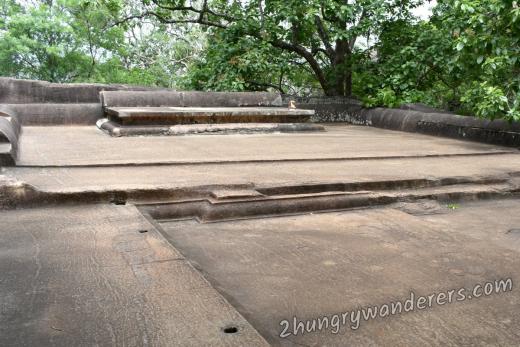
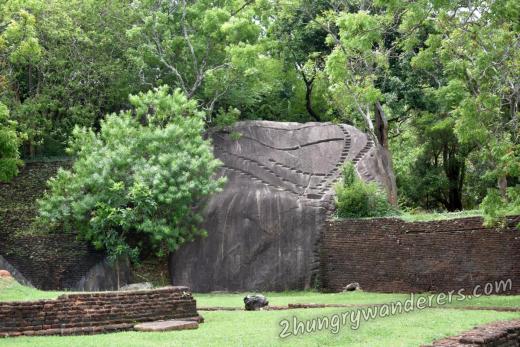
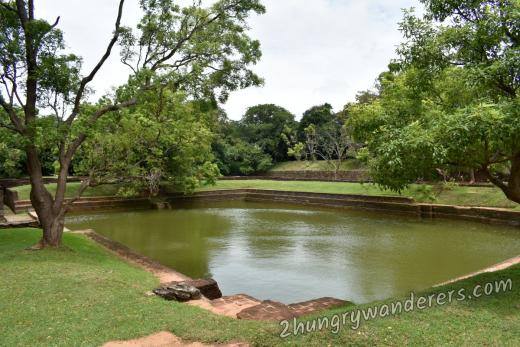
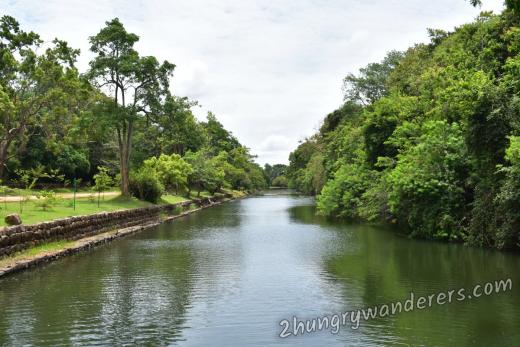


Comments